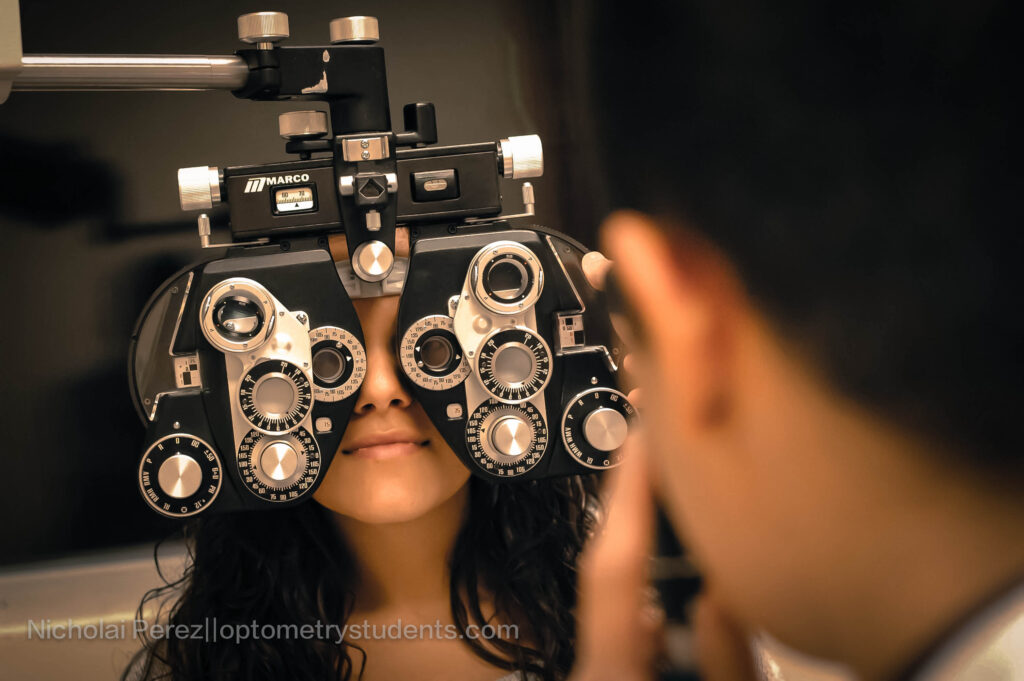If you are anything like me, being in the vision therapy clinic can feel a bit overwhelming! There are colorful objects hanging from the walls and ceiling, funny-looking devices spread around the room, and extremely distracting touch screen TVs that make all kinds of noises. Considering the numerous types of vision therapy activities, it can get confusing trying to learn them all. Vision therapy helps patients develop or improve fundamental visual skills and abilities by using different activities to help integrate functions of the eyes, body, and brain. (1) A poll of behavioral optometrists and vision therapists asked which were the top ten vision therapy activities every optometry student should know (and love!). Here are the results and a quick how-to for each activity.
1) Brock String
- White string with red, yellow, green, and blue beads
- Patient holds one end at bridge of nose and therapist holds other end
- Look at a bead 40 cm away from nose, keep clear, notice the strings form an “X” that cross at the bead (physiological diplopia)
- Good for: eye teaming, focusing, binocular awareness
2) Vectogram
- A transparent polarized stereogram placed in lightbox or in free space
- Using polarized glasses, stand or sit up straight, notice 3-D effect when the two transparent cards slide opposite each other for convergence and divergence
- Good for: eye teaming, binocular awareness, SILO (Small in Large Out)
3) Space Fixator
- A stand with a circular, transparent screen with circular targets around the border and a central fixation target
- Stand in front of space fixator with hands to the side, look at center target while noticing the different targets in the periphery
- Use eyes or fingers to touch the peripheral targets while fixating centrally
- Good for: central and peripheral integration, eye-hand coordination, body awareness, saccades
4) Mental Minus
- Using a minus lens, patch one eye and use the other eye to look at a target and see if the image changes when the lens is in front of the eye and when it is taken off
- Good for: flexibility of accommodative system, just noticeable difference
5) Yoked Prisms
- Use 5, 10, or 15 prism diopter yoked prisms
- Put on yoked prisms, walk around and describe what is seen, what things look like around them, notice differences with BU, BD, BL, and BR
- Good for: Just noticeable differences, visual discrimination, spatial awareness
6) JND with prisms and lenses
- Lens sorting: using different powered lenses, ask if the patient can put the lenses in a particular order, noticing difference each lens has
- Loose prisms push the image toward the apex – hold the prism monocularly in front of the patient’s eye, and ask where the image moves
- Good for: Just noticeable difference, visual discrimination
7) Eccentric O’s
- Two circular O’s side by side on a transparent card with a smaller circle in the middle of each O
- Voluntarily cross and relax eyes to make a third 3-D image in the middle
- Good for: vergence ranges, spatial localization
8) Parquetry Blocks
- A set of colorful blocks that help develop matching and discrimination abilities using 3-D figures in one-to-one correspondence
- Good for: Visual discrimination, matching, spatial rotations, tactile feedback
9) After Image
- Flash an eye with an after image monocularly, have patient look at an object and notice if the flash is exactly at the point in which they are fixating
- Good for: fixation, spatial awareness
10) Near/Far Actitivies
- This includes many activities in which the patient looks from a near fixation target to a distance target ie. Bulls eye, Focus Flex
- Good for: accommodation, eye teaming, fixation
There is an infinite amount of vision therapy activities that, frankly, may be impossible to learn each and every one of. This list is a tiny yet important portion of those activities. Are there any additional activities you’d like to see on this list? Comment below – we’d love to get your opinion!
References
- College of Optometrists in Vision Development [http://www.covd.org/?page=Vision_Therapy]
- Sanet Course on Parquetry
Special thanks to contributors affiliated with:
- Alderwood Vision Therapy Center
- Western University College of Optometry
- Southern California College of Optometry


